Introduction
As artificial intelligence (AI) is rapidly developing, it is permeating our lives without our awareness. Among them, the chatbot in particular is rapidly being applied in various fields, including customer relationship management, commerce, and communication. A chatbot refers to a robot that communicates with humans based on AI and involves an AI program that operates with a request and response structure (Park, 2017).
According to market forecasting agency Markets and Markets (2019), the chatbot market is expected to grow from USD 2.6 billion in 2019 to USD 9.4 billion by 2024, at a CAGR (compounded annual growth rate) of 29.7% during the forecast period. Gartner (2011) has already predicted that more than 85% of customer interactions will be managed without people by 2020, and it is expected to become the number one AI consumer application in the future. In April 2016, the Facebook CEO, Mark Zuckerberg, released a chatbot API (application programming interface) at F8 (Facebook eight) developer conference, wherein he announced that “the future of Facebook is in messengers” (Lim, 2016). With the advancement of technologies such as AI, the increasing customer demand for self-service is driving companies to use chatbots. This is because 24/7 customer support is available through chatbots, which reduces operating costs, thereby enabling companies to achieve a competitive advantage by providing quick responses to customer inquiries (Markets and Markets, 2019).
Chatbots were introduced from the viewpoint of automating the processing of simple inquiries from customer centers. Previously, a chatbot used to be based on general rules and searches; presently, the chatbot supports a variety of non-face-to-face tasks such as delivery/return/cancellation, hospital reservation and interview processing, purchase-related product recommendations, and public service complaints. Chatbots are consequently emerging as indispensable in that they support non-face-to-face tasks involving communication between companies and customers in the “untact” (un+contact) era brought about by the coronavirus disease (COVID-19) pandemic. This study aims to examine the chatbots that have been growing in influence in various industries. With the progress in AI technology, advanced chatbots have begun to appear. Although AI-based chatbots have been introduced and are being used in service in Korea, we will focus on the overseas applications. This study explores the advantages of introducing chatbots and the different kinds of chatbot services operating abroad, in addition to determining potential changes in communication between companies and customers.
It will be necessary for future research and development to examine the current status of overseas chatbot development being used in the e-commerce field and to discuss ways to apply it to the Korean e-commerce field chatbot development. This study examines the development status of AI interactive chatbots in the field of e-commerce and aims to provide practical help for domestic AI content production companies to produce electronic commerce interactive chatbots. Therefore, the research questions reflecting this purpose are as follows.
First, what are the principles of the development of AI-based interactive chatbots and the recent developments?
Second, what is the principle of an intelligent chatbot system based on AI technology?
Third, considering the types of chatbot services through overseas cases, what are the ways to use them for domestic chatbot development?
Research on Chatbot
The interactive chatbot based on AI technology uses the natural language processing technology (NLP) of a computer program to enable users to chat with the chatbot and solve various problems while the chatbot responds appropriately (Kompella, 2018). AI technologies used in chatbots can be classified into five groups as shown in Table 1 (Choi & Nam, 2019).
Adapted from “The use of AI chatbot as an assistant tool for SW education,” by Choi and Nam, 2019. CC-BY-NC.
The type of chatbot depends on an operation method. There are rule-based chatbots and machine learning-based chatbots. In addition, there are one-time Q&A chatbots and continuous conversational chatbots according to the information exchange method. According to the answer generation method, it can be classified into a search model chatbot and a generation model chatbot (Kim, Shin, & Kang, 2018). The following figure shows four types of chatbots. The rule-based chatbot in Figure 1 is relatively easy to implement, but it takes a long time to well define many rules. The better the rules are, the higher the quality of conversation service is possible. The machine learning-based chatbot in Figure 2 uses machine learning algorithms to understand natural language and generate or select appropriate answers. The NLP module plays the role of decomposing the natural language input by the user using various linguistic resources. On the other hand, the NLU module grasps the meaning of the decomposed natural language and delivers it to a generation model to generate a refined answer. A significant amount of linguistic data is required because a high level of NLP technology is required. The one-time Q&A chatbot in Figure 3 presents a set answer to frequently asked questions and is designed in a one-time Q&A format. Figure 4 shows a chatbot system that operates according to a specific scenario for a specific topic (Kim et al., 2018).
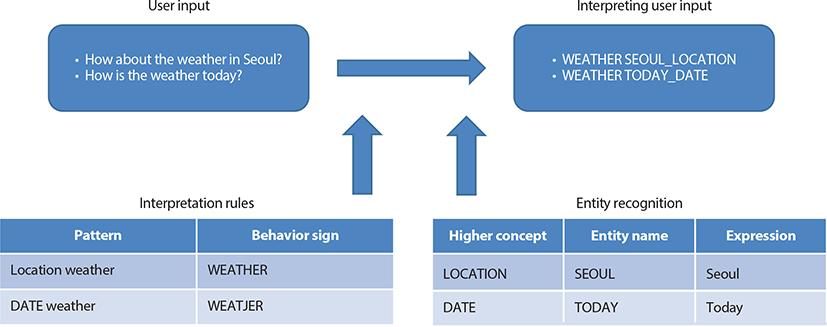
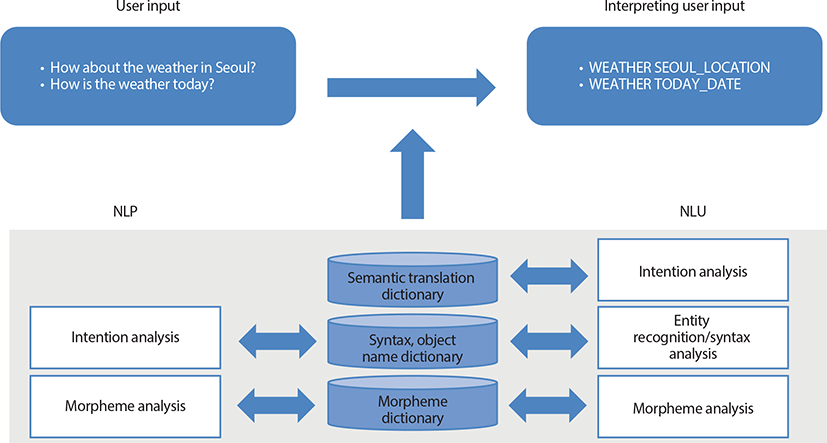
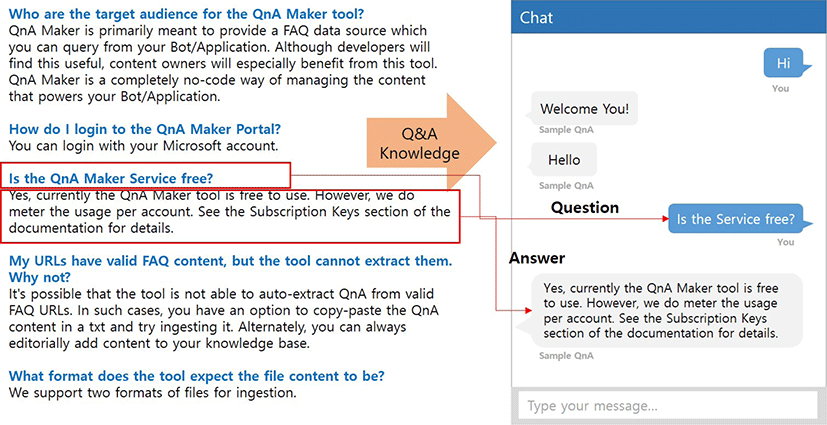

Research on chatbot is ongoing in various fields. In the field of language education, we are studying how chatbots are used for language learning. The use of chatbots for learning English (Lee, 2018), the development of AI chatbots for elementary English teachers (Min, 2019), and language learning through chatbots (Fryer, Nakao, & Thompson, 2019) are topics that have been studied. Research on the attitudes and behaviors of consumers who use chatbots are also being conducted (Lee & Park, 2019). This study introduces overseas chatbot cases in the field of e-commerce and compares them with Korean chatbot services. In this study, four cases are introduced.
Case studies are one of the most appropriate methods for exploring topics that have not been studied before (Yin, 1994), and this study attempted to introduce different services in the field of e-commerce by selecting multiple case study methodologies. The multi-case study method has the advantage of being able to explain the commonalities and differences between cases through comparative analysis by case. In this study, the study was conducted according to the existing study (Eisenhardt, 1991) that 4–10 cases are suitable when many representative cases cannot be found. Rather than presenting a large number of cases, the number of cases was selected with an emphasis on whether the number of cases and the number of newly acquired knowledge were proportional. Therefore, this study selected four representative cases and tried to select cases suitable for deriving the trend and advantage of the chatbot service using AI.
Chatbot Services in E-commerce
1-800-Flowers is an American florist and premium grocery retailer and distributor with annual sales of over USD 1.2 billion. It was also one of the first retailers to use interactive commerce over the Internet through chat or chatbot to sell directly to consumers. It is often considered an excellent example of a traditional company seeking to profit from the early phase of the newly introduced chatbot technology. 1-800-Flowers uses the Gwyn chatbot through Facebook Messenger. Its customers can order flowers and gifts through the chatbot and deliver them to anyone they want. The chatbot prompts customers to select items according to the type of event (birthday, romance, anniversary, etc.) and offers various gift options. They can buy flowers and receive delivery updates directly through the app. Previously, customers had to choose gifts directly from the e-commerce sites. Now, the site (https://www.1800flowers.com) can be easily navigated and customers can discover the right gifts and ideas according to the situation through a chatbot.
1-800-Flowers uses the Watson program (in partnership with IBM), an AI technology designed to transform the online customer experience with a smart virtual shopping assistant. 1-800-Flowers’ chatbot uses these AI technologies to present customized product offers to customers. The advantage is that it can handle all kinds of questions, ranging from ambiguous to specific. Gwyn asks some follow-up questions to ensure that the right product offer is provided. For example, if a customer wants to find a gift for their mother, Gwyn enquires about opportunities, emotions, and the types of product she likes. In addition, the more customers interact with Gwyn, the more intuitive the shopping experience can be refined over time.
1-800-Flowers has partnered with Amazon to enable customers to order gifts through voice using Echo, Echo Dot, Amazon tap, or Alexa. It is a very convenient and visionary service when combined with AI technology, and can potentially attract tens of thousands of new customers. 1-800-Flowers offers one of the most complete e-commerce AI experiences, integrating numerous technologies across multiple channels and websites. Thus, it is dedicated to providing convenience and excellent service to end consumers (eTail, 2020). Figure 5 is an example of 1-800-Flowers’ chatbot usage.
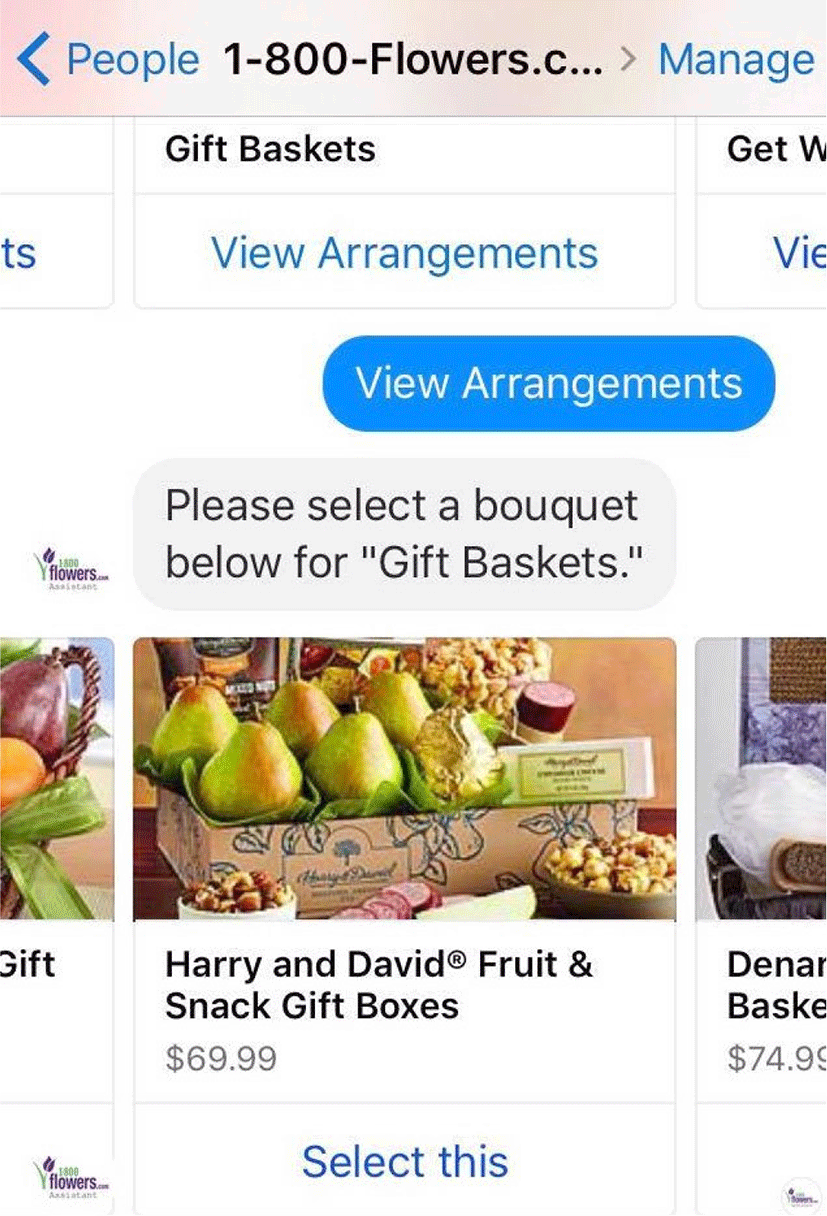
This chatbot is on a website and helps visitors quickly book movie tickets, view coupons, and leave feedback. Let us consider the case of PVR Cinemas, which owns one of the largest cinema chains in India. Its chatbot helps users make buying decisions by allowing its visitors to watch trailers of the movies they want to watch. This means that in addition to providing support, chatbots can also help increase sales. This chatbot application is not limited to cinemas. Performers, sports teams, organizations, nonprofit organizations, and anyone who creates events can use the chatbot to seamlessly sell tickets to fans and audiences.
PVR Cinemas reckoned that most customers ask the same type of questions about their purchases before making a decision to purchase a movie ticket. The company determined that increasing customer support efforts to answer these repetitive questions wasted valuable time and resources. As a better solution, the company deployed a chatbot on its website and designed it to answer basic questions that salespeople receive regularly. These questions include the following: Which movies are playing today? Which seats are available? Can I get a refund for my ticket? By answering these questions, the chatbot can guide customers and solve problems. In addition, a chatbot can also help the customer take the action they want (Rindell, 2019). Figure 6 shows the PVR Cinemas chatbot.

Sephora is a global company with over 2,300 stores in 33 countries worldwide. It operates a beauty retail store where customers can directly experience and purchase various products by selecting various cosmetic brands from the beauty industry. Sephora provides various services to customers through its chatbots, which use Kik Messenger. Customers take a quiz through a chatbot, delivering some of their key details, based on which the chatbot recommends the customer’s product. It also provides personalized beauty tips, product recommendations, and reviews. Like a real salesperson, the Sephora bot asks questions about taste in order to recommend the perfect product. Customers can purchase the products they like without leaving the messenger, through Sephora’s adaptation of Kik Messenger.
Sephora attempted to connect more effectively with customers online using AI. Facebook has developed a chatbot called Sephora Virtual Artist that allows people to try out lipstick colors using selfie photos. It also provides useful information for customers who want to learn about makeup through video clips and tutorials. The core objective of the Sephora bot is personalized product recommendation and product ordering through the chatbot (Quo, 2019). Figure 7 shows a list of lip gloss products being recommended through the Sephora chatbot.
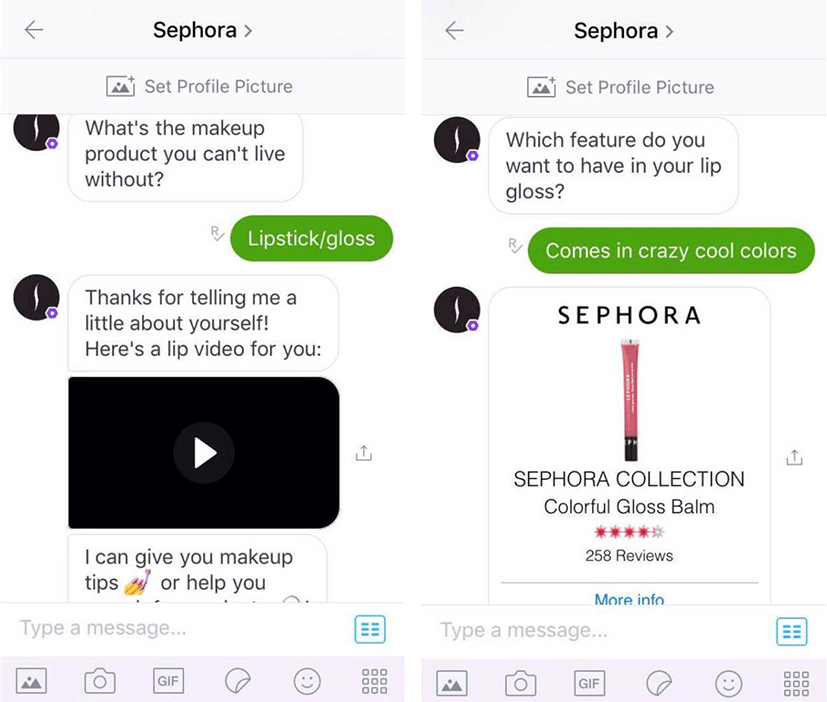
Companies can add chatbots to their websites and apps to engage customers. These chatbots can ask relevant questions, which provides a more engaging platform for customers to submit their contact information. In other words, the chatbot itself can serve as a great lead generation tool. When deploying a chatbot on a website, using rich conversations through the chatbot can engage customers in lead generation. Vainu, a data analysis service, uses VainuBot to ask questions to the customers who visit their website. Visitors can quickly select the option that is most relevant to them. Vainu can collect more information about their customers by asking multiple-choice questions through its chatbots and responding with new questions based on the visitors’ previous answers.
In particular, Vainu initiates a thoughtful conversation asking visitors what they want to do through VainuBot to collect email addresses from website visitors. VainuBot initially asks its visitors what they want to do. When someone selects the “Check Content” option, they will be asked what topics they are interested in. Subsequently, depending on their selection, Vainu provides a link to a case study that the visitors can get if they want. The conversation is much better than the traditional format because the visitor gets involved in the conversation and receives appropriate responses to the questions. This dramatically increases the likelihood of a visitor submitting their email address in exchange for a case study because the chatbot promotes meaningful conversations. With VainuBot, Vainu makes visitors feel welcome on their website, listens to their needs and requirements, and asks if they are interested in useful content such as eBooks, email courses, or demos. By interacting with its visitors in this manner, they build trust and collect visitors’ email addresses in exchange for providing useful content. This tactic allows businesses to send additional marketing emails that provide valuable content. Therefore, VainuBot generates leads on the website round the clock (Rindell, 2019). Figure 8 is an example of using VinueBot.
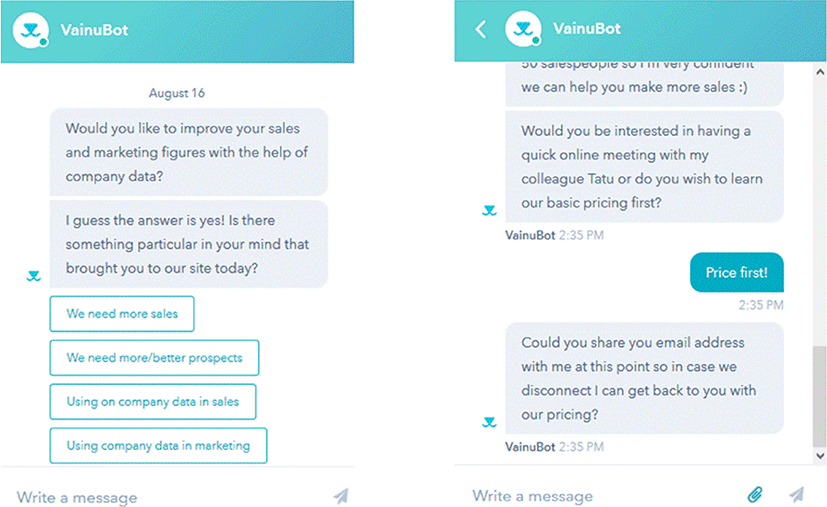
Discussion
Compared to other fields, chatbots have been around for quite some time in the field of e-commerce. When a shopper faced a problem or has a question, they used to call the company’s call center, and probably had to wait an average of 11 minutes to talk to a real person. However, through a chatbot, shoppers can receive an immediate response and only need to wait about 45 seconds. Excluding customer service, which is the field that uses chatbots the most, the core functions of chatbots in the e-commerce field, as gleaned from the four cases, are as follows.
First, the assist in finding products and sharing delivery information. Instead of searching for a product on a website, customers can directly purchase the product they want by sending a simple message to a chatbot, such as the case of 1-800-Flowers. Customers can save the time spent on searching for a product on the website, as they do not have to go through multiple steps. Chatbots can process online transactions, send users to different pages, and accept payments within the bot itself, instead of elongating the payment process. In addition, if customers want to know when the purchased product will be shipped, the chatbots can access real-time data to keep customers informed about where their products are located.
Second, it can also upsell to customers. AI chatbots for e-commerce can identify products and services that customers are interested in. Hence, they can recommend high-quality products that will serve customers better.
Third, it performs a marketing function. Chatbots can collect valuable customer information through questions. Companies are able to achieve clearer advertising effects through chatbots than email advertisements. Moreover, chatbots can push notifications of new product launches and offers according to customer preferences. They can be used to create targeted campaigns according to user preferences, thereby making personalized marketing possible through past conversations and interactions. Therefore, advertising through chatbots becomes a more economical and efficient approach to reach customers than conventional means.
Table 2 summarizes the characteristics of the four cases introduced in this study. The four cases are mostly machine learning-based chatbots using NLP technology. In Korea, various companies in the field of e-commerce have developed and used chatbots. SSG.com uses a chatbot to look at today’s dominance and tarot, and in the case of LG Electronics, through a chatbot, it provides consulting services such as product search and recommendation. However, the problem with most chatbots introduced in Korea is that chatbots do not come up with answers appropriate to the customer’s question, and in the end, they are led to an agent connection. In addition, since there are many rule-based chatbots and one-time Q&A types, it is difficult to receive product orders and product recommendations through natural conversations with a machine learning-based chatbot like in overseas cases.
In the future, in order to communicate smoothly with customers through chatbots in the field of e-commerce, the purpose of the service should be clear about what tasks the chatbot will replace. In addition, as in the case of overseas, a chatbot equipped with various functions for personalized recommendation should be operated. Like chatbots that sell products, features that allow chatbots to ask users first questions or induce games to understand users’ tastes through games should be installed.
Conclusion
This study examined the business value that companies can obtain by communicating with customers through chatbots, based on the four e-commerce cases that successfully used such chatbots. Sephora provides personalized services such as information delivery and recommendations through its chatbots, while 1-800-Flowers provides useful information to customers through interactive commerce services, as well as voice orders through Alexa for a convenient purchasing experience. PVR Cinemas uses its chatbot to support purchasing and reservation functions to quickly solve customer problems, while Vainu has demonstrated that its chatbots can acquire customer information and use it for marketing purposes by asking various questions to customers. In this study, we examined cases where a chatbot’s capabilities were successfully used in the field of e-commerce. Through this paper, it was confirmed that chatbots contribute towards improving the productivity and efficiency of existing business operations, and in particular, improving the convenience of customers’ shopping, ordering, and payment experiences. In addition, as companies seek to provide new shopping experiences to customers using chatbots, communication with customers through chatbots in e-commerce is expected to increase in the future. The limitation of this paper is that it derives business value based on a small number of cases. In the future, we intend to derive business value based on cases of chatbot services across various industries.






